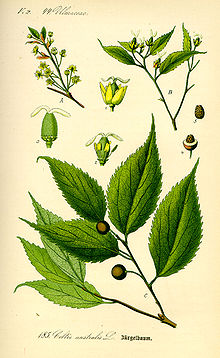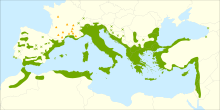bio.wikisort.org - Plant
Celtis australis, commonly known as the European nettle tree, Mediterranean hackberry, lote tree, lodogno or boboler (in Istria), or honeyberry,[2] is a deciduous tree native to Southern Europe, North Africa, and Asia Minor. The tree was introduced to England in 1796.[3]
| European nettle tree | |
|---|---|
 | |
| Celtis australis[1] | |
| Scientific classification | |
| Kingdom: | Plantae |
| Clade: | Tracheophytes |
| Clade: | Angiosperms |
| Clade: | Eudicots |
| Clade: | Rosids |
| Order: | Rosales |
| Family: | Cannabaceae |
| Genus: | Celtis |
| Species: | C. australis |
| Binomial name | |
| Celtis australis | |
 | |
| Distribution map | |
Description
The tree can grow to 25 m in height, though 10 m is more common in cooler climates. The bark is smooth and grey, almost elephantine.[4]
The alternate leaves are narrow and sharp-toothed, rugose above and tomentose below, 5–15 cm long and dark grey/green throughout the year, fading to a pale yellow before falling in autumn.
The apetalous wind-pollinated flowers are perfect (hermaphrodite, having both male and female organs), small and green, either singly or in small clusters.
The fruit is a small, dark-purple berry-like drupe, 1 cm wide, hanging in short clusters. They are edible and are extremely popular with birds and other wildlife.
- C. australis, Fox-Amphoux, France, planted 1550
- C. australis in Panchkhal VDC, Nepal
- Flower of C. australis
- C. australis autumn leaves
- C. australis Muntic, Croatia, planted in the early 16th century.
History
Celtis australis is supposed to have been the Lotus of the ancients, whose fruit Herodotus, Dioscorides, and Theophrastus describe as sweet, pleasant, and wholesome. Homer has Ulysses refer to the "Lotus-eaters" and the "lotus" in Odyssey, Book IX.[5]
It is often planted as an ornamental as it is long-living and resistant to air pollution. The fruit of this tree is sweet and edible, and can be eaten raw or cooked. The leaves and fruit are astringent, lenitive, and stomachic. Decoction of both leaves and fruit is used in the treatment of amenorrhoea, heavy menstrual and inter-menstrual bleeding, and colic. The decoction can also be used to astringe the mucous membranes in the treatment of diarrhea, dysentery, and peptic ulcers. A yellow dye is obtained from the bark. The wood is very tough, pliable, durable, and widely used by turners; the flexible, thin shoots are used as walking sticks.
Cultivation
The plant prefers light well-drained (sandy) and medium (loamy) soils, including those nutritionally poor; it can tolerate drought but not shade. The Mediterranean climate is especially suitable for the plant but it can tolerate colder climate (USDA Zone 7B). An article on Nettle tree cultivation is brought down in Ibn al-'Awwam's 12th-century agricultural work, Book on Agriculture.[6]
Common names
In different countries, Celtis australis is known under the following common names:
- Albanian: carac, Kaliboba;
- Arabic: الميس (mays);
- Bulgarian: копривка;
- Catalan: lledoner;
- Croatian: koprivić, obični koprivić, ladonja, farikul, fafarikula, pelegrinka, kostela, kostjela, koštela, košćela, koščela crna;
- English: the honeyberry tree, European hackberry, hackberry, nettle tree, Mediterranean hackberry;
- French: micocoulier;
- German: Zürgelbaum;
- Hebrew: מיש (mayish)
- Hindi: ku, batkar, khark, khirk, roku;
- Italian: perlaro, bagolaro;
- Kashmiri: Brimij
- Montenegrin: košćela;
- Nepali: khari;
- Polish: wiązowiec południowy
- Portuguese: lódão-bastardo, lodoeiro, ginginha-do-rei, agreira;
- Romanian: sâmbovină
- Slovenian: koprivovec;
- Spanish: almez, lodón, ladón, ojaranzo, hojaranzo;
- Turkish: adi çitlembik;
- Kurdish: Taug (تاوگ) ;
Trade names are: nettle wood, brimji.[7]
Notable trees
A large specimen planted in 1550 stands before the church in the village perché of Fox-Amphoux in the Provence region of southern France. The tree was 18 m in height with a circumference at breast height of 5 m in 2013.[8] In Islamic tradition, hackberry trees are considered holy and amulets made from their wood are employed to exorcise demons. The hackberry trees on the Temple Mount in Jerusalem are said to be the oldest in the world.[9]
The fruit and its effects are described in Tennyson's poem The Lotos-Eaters.
Secondary metabolites
The leaves of Celtis australis are a rich source of flavonoid C-glycosides.[10][11] Young leaves of Celtis australis from Northern Italy were found to contain the highest amounts of phenolics per gram dry weight. Amounts rapidly decreased until mid-May and after this date the level of phenolics fluctuated but showed no discernible trend. This general trend of high amounts of phenolics in the early growing season and a fast decline affected both caffeic acid derivatives and flavonoids.[12]
References
- 1885 illustration from Prof. Dr. Otto Wilhelm Thomé Flora von Deutschland, Österreich und der Schweiz 1885, Gera, Germany
- Bailey, L.H.; Bailey, E.Z.; the staff of the Liberty Hyde Bailey Hortorium. 1976. Hortus third: A concise dictionary of plants cultivated in the United States and Canada. Macmillan, New York.
- Hillier Nurseries Ltd. (1977). Hilliers' Manual of Trees & Shrubs, 4th edition, p.70. David & Charles, Newton Abbott, UK. ISBN 0-7153-7460-5
- More, D. & White, J. (2003).Trees of Britain & Northern Europe, p. 417. Cassells, London. ISBN 0-304-36192-5.
- Keeler, Harriet L. (1900). Our Native Trees and How to Identify Them. New York: Charles Scribner's Sons. pp. 249–252.
- Ibn al-'Awwam, Yahya (1864). Le livre de l'agriculture d'Ibn-al-Awam (kitab-al-felahah) (in French). Translated by J.-J. Clement-Mullet. Paris: Paris, A. Franck. pp. 311–312 (ch. 7 - Article 38). OCLC 780050566. (pp. 311-312 (Article XXXVIII)
- Celtis australis (Ulmaceae): Nettle Wood, Brimji.
- "Micocoulier, Fox-Amphoux (Var)". 24 April 2009.
- Jerusalem's Oldest Guardians: Hackberry Trees on the Temple Mount, Haaretz
- Spitaler, R; Gurschler, S; Ellmerer, E; Schubert, B; Sgarbossa, M; Zidorn, C (2009). "Flavonoids from Celtis australis (Cannabaceae)". Biochemical Systematics and Ecology. 37 (2): 120–121. doi:10.1016/j.bse.2008.11.020. ISSN 0305-1978.
- Kaltenhauser, M; Ellmerer, EP; Zidorn, C (2010). "Rhamnopyranosylvitexin derivatives from Celtis australis". Journal of the Serbian Chemical Society. 75 (6): 733–738. doi:10.2298/JSC090817049K. ISSN 1820-7421.
- Sommavilla, V; Haidacher-Gasser, D; Sgarbossa, M; Zidorn, C (2012). "Seasonal variation in phenolics in leaves of Celtis australis (Cannabaceae)". Biochemical Systematics and Ecology. 41: 110–114. doi:10.1016/j.bse.2011.12.028. ISSN 0305-1978.
На других языках
[de] Europäischer Zürgelbaum
Der Europäische Zürgelbaum[1] oder Südliche Zürgelbaum[2] (Celtis australis) ist ein mittelgroßer Baum mit meist glatter Stammborke, derben Blättern und essbaren Steinfrüchten. Die Pflanzenart gehört zur Gattung der Zürgelbäume (Celtis), die früher der Familie der Ulmengewächse (Ulmaceae) zugerechnet wurde, nach neueren Erkenntnissen aber in die Familie der Hanfgewächse (Cannabaceae) eingeordnet wird. Er wird oft unpräzise einfach „Zürgelbaum“ genannt, obwohl der Gattung etwa 100 Arten angehören. Das natürliche Verbreitungsgebiet der Art erstreckt sich über den Süden Europas, Teile Afrikas und die Türkei. Der deutsche Name Zürgelbaum stammt aus Südtirol, wo die Früchte Zürgeln genannt und in Backwaren und für Süßspeisen verwendet werden. Das harte aber elastische Holz wurde zur Herstellung von Musikinstrumenten, Wagenrädern und Rudern verwendet.- [en] Celtis australis
[es] Celtis australis
Celtis australis, conocido como lodón,[1] almez,[2] aligonero, ledonero, lodoño, quicavero o latonero es una especie de árbol tradicionalmente incluida en la familia de las ulmáceas (Ulmaceae), aunque en la actualidad se incluye dentro de las cannabáceas, una familia próxima. Lodón proviene del cruce del latín lotus y unĕdo con -ōnis (mirra). Nombre que recibía el loto. Es por ello, que posiblemente se trate del árbol al que los clásicos (Heródoto, Dioscórides o Teofrasto) llamaron Loto.[fr] Micocoulier de Provence
Celtis australis[ru] Каркас южный
Каркас южный (лат. Celtis australis) — дерево, вид цветковых растений рода Каркас (Celtis) семейства Коноплёвые (Cannabaceae).Другой контент может иметь иную лицензию. Перед использованием материалов сайта WikiSort.org внимательно изучите правила лицензирования конкретных элементов наполнения сайта.
WikiSort.org - проект по пересортировке и дополнению контента Википедии




